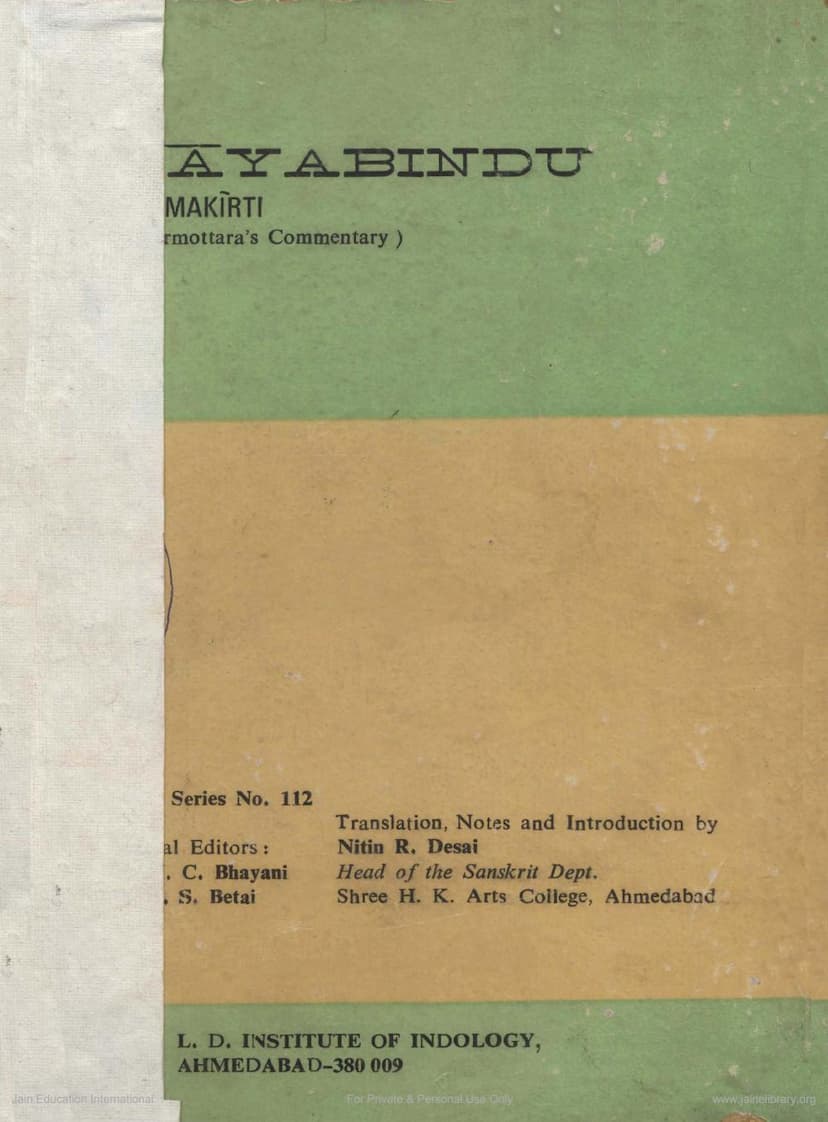Nyayabindu
Added to library: September 2, 2025

Summary
Here's a comprehensive summary of the Jain text "Nyayabindu" by Dharmakirti, based on the provided text and catalog link:
Title: Nyayabindu (with Dharmottara's Commentary)
Author: Dharmakirti
Commentary: Dharmottara
Translator, Notes & Introduction: Nitin R. Desai
Publisher: L. D. Institute of Indology, Ahmedabad
Series: J. D. Series No. 112
Overall Theme:
The "Nyayabindu" is a foundational work in Jain logic and epistemology, specifically focusing on the Buddhist school of thought within Indian philosophy. The text, with Dharmottara's insightful commentary and Nitin R. Desai's meticulous translation and notes, aims to elucidate the principles of valid knowledge (pramana) and logical reasoning. It emphasizes the importance of clear and precise understanding to achieve liberation and well-being.
Key Concepts and Structure:
The "Nyayabindu" is structured into three main sections, dealing with different aspects of knowledge and inference:
-
Pratyaksa (Perception): This section delves into the nature of direct perception, defining what constitutes valid perception. It discusses how sensory experiences, when free from errors in cognition (kalpana) and inaccuracies (abhranta), lead to true understanding. It also touches upon the role of the mind and other internal senses in perception. The text distinguishes between different types of perception and their validity.
-
Svarthanumana (Inference for Oneself): This section focuses on inferential reasoning that an individual undertakes for their own understanding. It elaborates on the structure of inference, particularly the concept of the 'hetu' (reason or middle term) and its essential characteristics (tri-rupa linga). The text meticulously analyzes the conditions under which an inference is valid, outlining various fallacies (hetvabhasas) that can arise from flawed reasoning. This includes discussing concepts like anvaya (concomitance in presence) and vyatireka (concomitance in absence).
-
Pararthanumana (Inference for Others): This final section deals with the presentation of logical arguments to convince another person. It outlines the structure of syllogistic reasoning, including the role of premises, conclusion, and the logical relationship between them. Dharmakirti, through Dharmottara's commentary, emphasizes the correct formulation of arguments to avoid fallacies and ensure clarity. This section also includes a detailed discussion on various logical fallacies related to the 'hetu' (reason) and the 'drstanta' (example), explaining how flawed examples can lead to incorrect conclusions.
Central Arguments and Philosophical Standpoint:
- Pramana (Valid Knowledge): The text places immense importance on the means of valid knowledge. It argues that only through correct perception and logical inference can one attain true understanding of reality.
- Epistemological Rigor: Dharmakirti, as a prominent Buddhist philosopher, emphasizes a highly analytical and empirical approach to knowledge. The "Nyayabindu" is a testament to this, dissecting concepts of perception and inference with remarkable precision.
- The Nature of Reality: While primarily an epistemological and logical text, the "Nyayabindu" implicitly points towards the Buddhist understanding of reality, particularly the concepts of impermanence (kshana-bhanga) and non-self (anatta), which inform its epistemological framework.
- Critique of Other Philosophical Systems: The text, through its detailed analysis of logical fallacies and its nuanced definitions, implicitly critiques other Indian philosophical schools (like Nyaya, Samkhya, Mimamsa) by highlighting the limitations of their logical frameworks or the potential for error in their reasoning processes.
- The Importance of Clarity: The emphasis throughout the text is on achieving clarity of thought and expression, both in one's own reasoning and in presenting arguments to others. This is crucial for dispelling ignorance and achieving spiritual goals.
- The Role of Language: The text also implicitly discusses the role and limitations of language in conveying knowledge, particularly the distinction between conventional truth (samvriti-satya) and ultimate truth (paramartha-satya).
Significance of the Commentary and Translation:
- Dharmottara's Commentary: Dharmottara's commentary is highly regarded for its clarity and ability to elucidate the subtle points of Dharmakirti's dense philosophical arguments. It is considered essential for understanding the "Nyayabindu."
- Nitin R. Desai's Contribution: Nitin R. Desai's translation and extensive notes are invaluable for making this complex philosophical text accessible to a wider audience. His introduction likely provides historical and philosophical context, and his notes offer scholarly insights into the nuances of the text and its interpretation.
In essence, the "Nyayabindu" is a rigorous exploration of logic and epistemology, offering a systematic framework for understanding reality through valid means of knowledge. It highlights the interconnectedness of perception and inference, the pitfalls of faulty reasoning, and the ultimate goal of achieving clear and correct knowledge for spiritual progress.